|
Special Features





Image Libraries


|
|
Blog
Mayor Bowser's latest DC budget proposal includes $165 million to replace the Hopscotch Bridge. Once a new bridge is open, an eyesore will become a prime public space, and long-awaited expansions of Union Station and DC Streetcar can finally happen.

Rendering of the new Hopscotch Bridge, surrounded by new development behind Union Station. Image by Akridge.
Today, Hopscotch Bridge carries H Street over the railroad tracks behind Union Station. In order to make room for trains to pass below, the bridge rises high above H Street's normal elevation. With solid walls and the Union Station parking garage on either side, the bridge is a three block long stretch of desolation, amid an otherwise vibrant part of the city.
Replacing the bridge will change that.
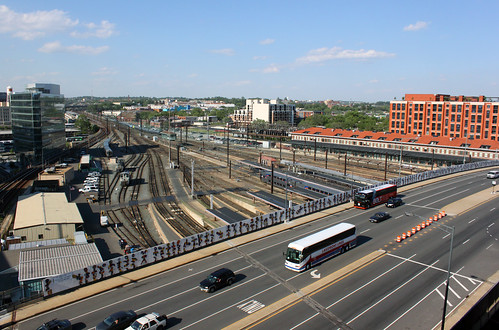
Existing Hopscotch Bridge. Image by Bossi licensed under Creative Commons.
A new bridge, designed specifically to accommodate buildings on either side, will make it possible to develop the air rights above Union Station's railyard, and to replace the parking garage with a new train hall. What was desolate will become a major new public space, with landmark architecture, a mix of uses, and a more open, European-style train hall.
That development is called Burnham Place. It's a very ambitious plan.

Proposed H Street entrance to Union Station, as part of Burnham Place. Image by Akridge.
Streetcar can go downtown
Building a new Hopscotch Bridge also opens to door to finally extending the H Street Streetcar to downtown Washington and Georgetown. The streetcar doesn't specifically need a new bridge, but timing is an issue. DDOT doesn't want to extend the streetcar now only to rip up tracks and suspend service in a couple of years when the bridge is torn down and replaced anyway.
As it is, tearing down and replacing the existing bridge will mean temporarily removing the streetcar stop atop the bridge. That's bad enough, but it would be a much worse situation with streetcars running downtown.
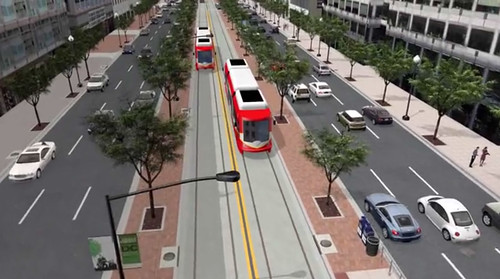
When it runs downtown, DC Streetcar will have a dedicated transitway. Image by DDOT.
Budget details
Mayor Bowser's proposal would fund $165 million in 2019 and 2020. The DC Council will have to approve the budget before it becomes law. Even if it does, another $40 million would still be needed before construction could begin. That money would either come from other sources, or a future year's budget.
Once funding is fully in place and DDOT completes the final design, construction should take about two years.
 Comment on this at the version cross-posted to Greater Greater Washington. Comment on this at the version cross-posted to Greater Greater Washington.
Average Rating: 4.8 out of 5 based on 214 user reviews.
April 4th, 2017 | Permalink
Tags: development, funding, government, master planning, roads/cars, streetcar, transportation

In the late 1950s and early '60s, as Washington's original streetcar system slowly converted its rail lines to buses, owners sold or gave away nearly 200 of DC's best railcars to any city that would take them. Those cars ran for decades all over the world. But time takes its toll, and today only one remains in anything like active service: Car #71 in Sarajevo, Bosnia and Herzegovina.

The last old DC Transit streetcar still in service, in Sarajevo. Image by Fototak on Flickr, used with permission.
Sarajevo took a total of 71 PCC streetcars from DC between 1958 and 1962, running most of then until the late '70s. Fascinatingly Sarajevo's transit company combined some of the streetcars into longer articulated ones, and ran them as double units. They may have been the only PCC cars to ever become articulated.
By the 1980s most of Sarajevo's DC railcars were retired. But one, car #71, has remained in service, sort of. It survived the brutal 1990s Siege of Sarajevo, and remains part of the tram fleet today, as a vintage model.
It doesn't run every day, nor even most days. But it's still brought onto the streets to carry passengers during special events.
It's the only remaining vintage DC streetcar that ever carries actual transit passengers.
For the record, San Francisco's Market Street Railway has a car painted to look like an old DC streetcar, but beneath its paint the railcar itself ran in Minneapolis and New Jersey.
What happened to the rest?
Prior to the sell-off, DC Transit, the streetcar operator of the late '50s and early '60s, owned 450 railcars.
Barcelona, Spain took 101 of them, and ran them until 1971. None of those remain in service, but four remain in museums or private collections.
15 of them went to America's only private subway system, the Tandy Center Subway in Fort Worth, Texas. Their new owners modernized the cars and ran them until the subway ended service in 2002. One of those 15 old streetcars went to the McKinney heritage streetcar line in Dallas where it ran until 2006, when mechanical and electrical problems forced it out of service.
Three more of the Fort Worth railcars still exist. A group working to start a Texas transportation museum owns them, and hopes to use them as exhibits.
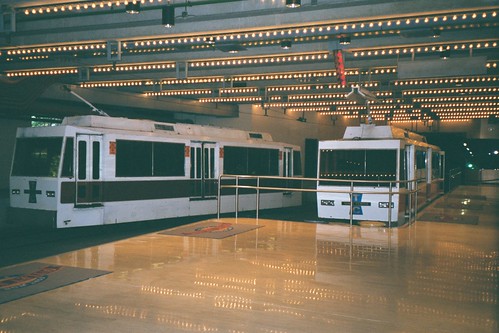
Former DC Transit streetcars running in the Tandy Center Subway in 2002. Image by Justin Smith on Flickr, licensed under Creative Commons.
Thirteen other DC Transit streetcars remain in museums around the United States.
The Smithsonian owns two, including one on public display at the American History museum.
Seven remain at the National Capital Trolley Museum in Montgomery County. Three others there were lost in a fire in 2003.

Former DC streetcar at the National Capital Trolley Museum.
Four other railcars remain at museums in Virginia, Pennsylvania, Connecticut, and Maine.
The other roughly 250 streetcars were scrapped and lost to history.
Thanks to GGWash commenter Bob Shackleton, who tipped us off about Sarajevo.
 Comment on this at the version cross-posted to Greater Greater Washington. Comment on this at the version cross-posted to Greater Greater Washington.
Average Rating: 4.4 out of 5 based on 155 user reviews.
March 9th, 2017 | Permalink
Tags: history, streetcar, transportation

Happy birthday, DC Streetcar! Yesterday was the first anniversary of opening day. This year hasn't been perfect, but the streetcar steadily gained riders and has generally beaten expectations.
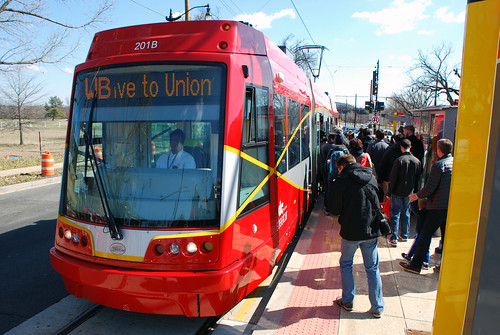
According to monthly ridership reports, January 2017 was the streetcar's busiest month yet, in both total riders for the month and in average riders per weekday.

January 21, the day of the Women's March, was the busiest single day since opening day itself, with 7, 347 riders. That was a Saturday, though, and obviously a unique event.
The bigger story is how weekday ridership has grown over the year. For most of the streetcar's first six months open, more people rode on Saturdays than on any weekday. But as people have become familiar with the streetcar, it's evolved from curiousity to reliable fact of life. The number of people riding just to check it out has dropped, while those using it to commute has shot up.
In January, for the first time, ridership passed above 3, 000 per weekday. At that level, the streetcar is performing at 236% of DDOT’s pre-opening estimate of 1, 300 daily riders.
That's far below the roughly 14, 000 people who ride H Street buses every day, but it's not bad given the shortness of the line, and the trend is strongly positive.
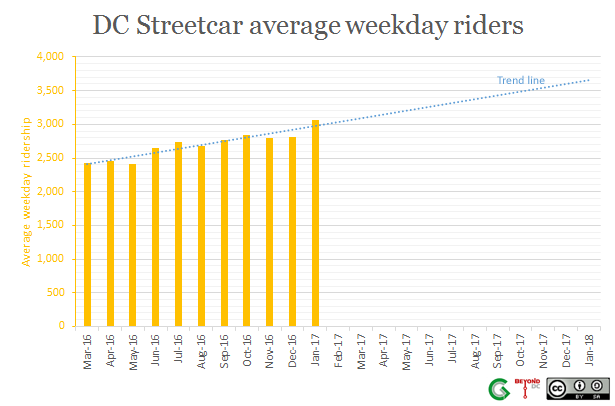
Far from perfect, but better than expectations
The streetcar would still fare better with dedicated lanes, and the crossovers at 3rd Street and Starburst still slow most trips. Those problems absolutely exist. But they haven't derailed the entire operation.
According to Martin DiCaro's WAMU story on the anniversary, the streetcar is marginally faster than the X2 thanks to fewer stops and faster loading, and is doing so well that DDOT is considering improving service to run every nine minutes.
For a line that had the roughest of openings, it's been a surprisingly good year.
 Comment on this at the version cross-posted to Greater Greater Washington. Comment on this at the version cross-posted to Greater Greater Washington.
Average Rating: 5 out of 5 based on 193 user reviews.
February 28th, 2017 | Permalink
Tags: streetcar, transportation

Do you know a DC newbie who needs a primer on how to get around the city without a car? I wrote one for ApartmentGuide.com. Check it out!

DC bus map, learn to love it to unlock the city.
Average Rating: 4.8 out of 5 based on 228 user reviews.
November 29th, 2016 | Permalink
Tags: bike, bus, metrorail, pedestrians, roads/cars, streetcar, transportation

Tuesday, May 17 was all-streetcar-all-the-time day on GGWash. We reviewed the H Street streetcar’s operations, and reported on expansion issues both east across the Anacostia and west into downtown.

DC Streetcar on K Street Transitway. Image from DDOT.
Here’s a rundown of all the posts:
Average Rating: 4.8 out of 5 based on 159 user reviews.
May 20th, 2016 | Permalink
Tags: streetcar, transportation

The DC Streetcar is drawing a decent number of riders, so far. Compared to other US light rail and streetcar systems, it ranks near the middle in terms of riders per mile of track. It’s slightly above average, neither horrible nor spectacular.
According to DDOT’s latest streetcar ridership report, the H Street line carried an average of 2, 285 passengers each weekday in April. It carries more on Saturdays, but weekday ridership is the standard measuring stick nationwide.
In raw terms, 2, 285 riders per day is pretty low. But for a line that only carries passengers for 1.9 miles, it’s actually not bad.
Middle of the light rail pack
Obviously, the 1.9 mile DC Streetcar isn’t going to carry nearly as many passengers as, say, the 90-mile-long Dallas light rail system. And if you rank all US light rail and streetcar systems by total ridership, DC’s 2, 285 passengers per day is indeed near the bottom, at 31st out of 37. Dallas is 7th with about 105, 000.
But to get a sense of how successful these lines are at attracting riders, we need to compare them on an apples-to-apples basis. To do that, divide the total daily ridership by the number of miles, to get ridership per mile.
And in those terms, DC Streetcar’s 1, 203 riders per mile is a respectable 18th out of 37. It’s just barely in the upper half nationally. And it doesn’t even go downtown yet.
Dallas is actually lower at 1, 164 riders per mile. Other regional light rail systems that are lower than DC Streetcar include Baltimore (691 riders/mile), Norfolk (784), Sacramento (1, 056), Saint Louis (1, 035), Pittsburgh (850), and Cleveland (467).
On the other hand, DC is far below the number one system on the list: Boston’s Green line light rail, which carries a whopping 7, 126 riders per mile. Other systems near the top include San Francisco’s Muni Metro (4, 370 riders/mile), Minneapolis (3, 275), New Jersey’s Hudson-Bergen light rail (2, 852), and the Portland streetcar (2, 723, which is interestingly higher than Portland’s MAX light rail at 2, 048).
Compared to H Street’s X2 bus
What about buses?
In terms of raw riders, the X2 bus on H Street is the 3rd busiest bus line in the WMATA system, with 17, 400 riders per day as of 2015. The X2 is almost exactly 5 miles long, pegging it at 3, 480 riders/mile.
So the streetcar is attracting about one third as many riders as the X2 was before the streetcar started, mile for mile.
But the X2 is a tall order to match. If it were light rail or a streetcar, the X2’s 3, 480 riders/mile would make it the third best system in America, after only Boston and San Francisco. That’s one of the reasons a bigger and nicer vehicle makes sense there in the first place.
Plenty of room for improvement, but riders are there
Clearly the streetcar isn’t perfect. Getting it open was a saga, and its lack of dedicated lanes or traffic signal priority continue to hurt. Future lines absolutely need to be better, and can be better.
And who knows what will happen if DDOT ever starts charging a fare. Atlanta streetcar ridership plummeted when it went from free to $1, but Portland’s streetcar ridership remains high despite adding fares after 11 years of free rides, so that’s hard to predict.
But in terms of attracting riders, DC Streetcar isn’t doing particularly badly.
You can help make sure the next extensions are indeed better by attending upcoming planning meetings, May 17 for the Georgetown extension, and May 19 for Benning Road.
 Comment on this at the version cross-posted to Greater Greater Washington. Comment on this at the version cross-posted to Greater Greater Washington.
Average Rating: 4.9 out of 5 based on 287 user reviews.
May 13th, 2016 | Permalink
Tags: streetcar, transportation

DC Streetcar is open and carrying passengers, following a festive opening day on Saturday. Enjoy this photo tour reliving the fun.

 Continue reading at Greater Greater Washington Continue reading at Greater Greater Washington
Average Rating: 4.9 out of 5 based on 272 user reviews.
February 29th, 2016 | Permalink
Tags: events, galleries, streetcar, transportation

DC Mayor Muriel Bowser just announced the H Street streetcar will officially open to passengers on Saturday, February 27. Of this year. Hallelujah!
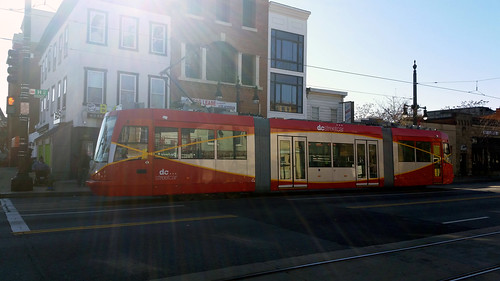
Mayor Bowser’s announcement should mean the DC fire department has certified the streetcar as safe to run and submitted its paperwork to the federal government, thus accomplishing the last step before the streetcar can open. With that done, it’s ready to carry passengers.
The opening party and first passenger-carrying run will take place at 10:00 am on Saturday, February 27, at the corner of H Street and 13th Street NE.
After that, streetcars will run between Union Station and Oklahoma Avenue every 15 minutes the rest of the day. Rides will be free for everyone for the first few months.
The streetcar will close again Sunday the 28th; for now it’s only scheduled to run six days per week. But passengers will be able to pick it up again on Monday the 29th, and every day thereafter except Sundays.
Many of us will be there to enjoy the festivities, and we’ll try to all meet up to make a GGWash contingent. Join us if you can! Or ride the streetcar to our 8th birthday party on March 8. Or both!
 Comment on this at the version cross-posted to Greater Greater Washington. Comment on this at the version cross-posted to Greater Greater Washington.
Average Rating: 4.7 out of 5 based on 188 user reviews.
February 18th, 2016 | Permalink
Tags: events, streetcar, transportation

|
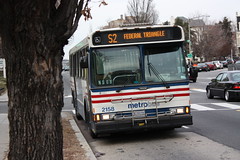
Photo by truthaboutit on Flickr. |
It won’t appear immediately, but DC took a big step toward speeding up buses on 16th Street by recommending a rush-hour bus lane and a package of other ways to make bus service better.
Keep reading this joint post at Greater Greater Washington.
Average Rating: 4.6 out of 5 based on 214 user reviews.
December 17th, 2015 | Permalink
Tags: BRT, bus, streetcar, transportation

Earlier this year, outside experts identified 33 issues for DDOT to address before the H Street streetcar can open. According to DDOT spokespeople, 12 of those 33 have since been completely fixed. The remaining 21 are in progress.
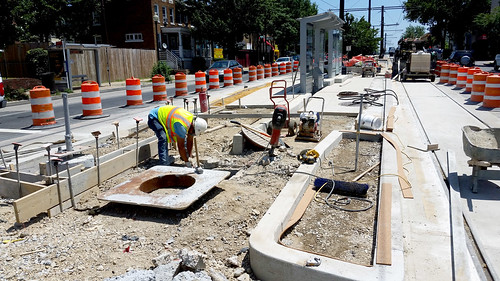
Workers modify 19th Street station following an APTA review of the DC Streetcar.
According to new DC Streetcar Launch Manager Timothy Borchers, workers are making significant progress towards satisfying the 33 recommendations from this spring’s APTA review.
Borchers himself is one of the solutions. DDOT hired him this spring, following an APTA recommendation that DDOT bring on more experienced project managers. Borchers worked for years on the world’s largest streetcar network in Melbourne, Australia, and helped launch the new Atlanta Streetcar in 2014.
Progress report
During an interview with reporters last week, Borchers didn’t supply a specific list of exactly which 12 of the 33 total items are complete. But he did outline DDOT’s recent progress.
Among the items that are complete: Crews have repaired the three cracked tracks, several new staff people have been hired (including Borchers himself), DDOT has finalized its pre-revenue operations plan, and crews now track all streetcar work using a single master matrix.
As for the rest, all 21 remaining items “are in some stage of completion, ” says Borchers.
Platform modifications
The most visible work in progress now is retrofitting the 19th Street station to meet disability accessibility standards. The slope of the concrete in the original platform was a few degrees off from federal requirements. Therefore, crews are now re-leveling the platform.
Workers may soon begin modifying other platforms, to prevent streetcar doors from scraping against the platform edge. Although Borchers was careful to note that DDOT is still in the process of determining its exact solution to the scraping problem, he says it’s being caused by the streetcars’ self-leveling system, hydraulics that keep streetcars level with the platforms at stations.
Workers may only need to fine-tune the streetcars’s self-leveling system, but it may also be necessary to adjust some of the platforms.
Meanwhile, engineers are working on a new design for a set of stairs near the streetcar railyard, where the narrow landing between the bottom of the stairs and the edge of the streetcar tracks is potentially dangerous. The new design will add a “pivot, ” so the stairs empty onto a landing parallel to the tracks rather than leading directly into them.

Existing stairs leading straight to the streetcar tracks. Photo from DDOT.
Streetcar vehicle fixes
Inside the car barn, changes are underway to the streetcar vehicles themselves.
After one of DC’s streetcars caught fire in February, analysis determined the cause was inadequate insulation on the pantograph—the electrical mechanism connecting the streetcars to the overhead power wires.
Although it was a DC streetcar that caught fire, the problem was with the railcar’s design. Thanks to lessons learned from the DC fire, all streetcars nationwide manufactured by United Streetcar are now being retrofitted with improved insulation.
If you spot a United Streetcar on Benning Road, its retrofit is complete and its pantograph is safe.
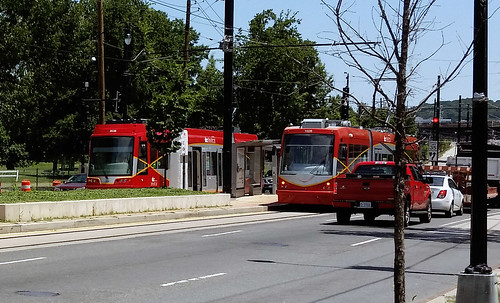
A retrofitted United Streetcar (left), with a Czech-built streetcar (right) on Benning Road, on Thursday, July 16.
Another change coming to the railcars is rear-view cameras. The APTA review recommended replacing rear-view mirrors with cameras in order to narrow the profile of the railcars, to help avoid side collisions with parked cars.
As of Thursday, the cameras have been installed but the mirrors have not yet been removed.
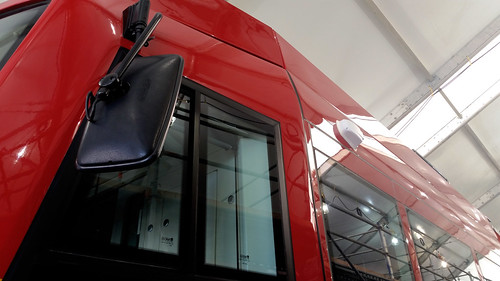
The white attachment at upper right is the new rear-view camera.
No fences for Benning Road
One APTA recommendation that DDOT has decided to only partially implement is the suggestion to add fences to H Street and Benning Road, in order to cut down on jaywalking.
Borchers explained that while fencing can be appropriate for rail lines in other types of environments, it’s inherently incompatible with a busy main street where there are lots of pedestrians. DDOT will install a short segment of fencing on the Hopscotch Bridge, but otherwise H Street and Benning Road will remain fence-free.
Instead, more signs and pavement markings will warn pedestrians to watch out for streetcars.
Next steps
According to Borchers, DDOT workers will continue to power through the remaining 21 items this summer, working towards final certification from DC’s safety oversight office.
When everything is finally ready to go, the streetcar will enter a final pre-revenue operations phase, simulating the exact operations of passenger service.
Since DDOT already performed significant pre-revenue operations in the waning days of the Gray administration, they’ll be able to follow a reduced timeline on this second go around. Once it begins, that will likely take two to three weeks, if everything goes well.
 Comment on this at the version cross-posted to Greater Greater Washington. Comment on this at the version cross-posted to Greater Greater Washington.
Average Rating: 4.4 out of 5 based on 236 user reviews.
July 21st, 2015 | Permalink
Tags: streetcar, transportation

|
Media





Site
About BeyondDC
Archive 2003-06
Contact
Category Tags:
Partners
|




 Comment on this at the version cross-posted to Greater Greater Washington.
Comment on this at the version cross-posted to Greater Greater Washington.


























